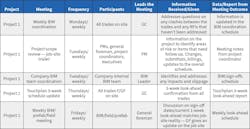Project Management Tools for Efficient Job-Site Practices
All our jobs are taken with the expectation that we create an accurate estimate and a good plan of attack to complete the work in a timely, efficient, and profitable manner. Our best-run jobs follow that planning with an execution that ensures these results are delivered. For most jobs, the estimate and planning can be completed with just a few people working closely together. Still, the installation phase generally requires a lot of people working simultaneously and not necessarily close together, making verbal information sharing difficult.
Preconstruction can often be effectively accomplished with a few people who understand the work and customer’s needs and have some individual experience/knowledge (also known as tacit knowledge) that they can lean on to make a good plan. However, successfully sharing that experience and knowledge to help the entire installation team perform with the same continuity of preconstruction requires that tacit knowledge be transferred into explicit knowledge.
From tacit knowledge to explicit knowledge
No aspect of our interaction supports the transfer of tacit to explicit knowledge more strongly than our communication. Everything from face-to-face meetings to phone calls to emails to text messages set up these communications. How and what we communicate dictate the effectiveness of this process. Most job-site interactions are built on tacit exchange, such as progress meetings, laydown area discussions, and informal meetings “in the trailers.” All provide an avenue for exchanging firsthand experience and knowledge related to the job. This is very effective to ensure that everyone has the same current understanding of status, but it has its shortfalls. Tacit exchanges like these provide the content for setting up the transfer to explicit knowledge, but that action doesn’t happen naturally.
Simple tools like notebooks and cameras capture observations but do not easily support sharing in a manner easily retrieved and searched by others. Operationally focused tools such as Short Interval Scheduling (SIS®) and Job Productivity Assurance and Control (JPAC®) are designed specifically to digitize workplace observations into a format that can be easily shared and searchable. Even time sheets provide better communication than a notebook full of sketches or a free-flow discussion at the coffee pot.
Avoiding project risk through explicit knowledge
Project risk comes from not seeing issues that could be seen or not seeing issues soon enough to prevent them. The effective transfer of the information to explicit happens when we can take that common information and knowledge among all stakeholders. The most immediate results come from taking project information from the job site and translating that into impacts that will alter our completion time, cost, and quality. These impacts form the basis of project meetings and project reviews for early detection and correction of the impacts.
Examples of effective transfer of tacit knowledge on the job site to explicit knowledge within the business system can be seen easily using properly built project models and schedules, such as:
- Daily installation nuisances can be translated into schedule impacts.
- Change-orders can be translated into productivity impacts.
- Material delays can be seen as missed deadlines, labor stacking, and even liquidated damages.
In the following examples, the use of simple tools designed to capture tacit knowledge and support the transfer to explicit analysis in the project model can be seen clearly. In the three cases shown, the first two use more meetings but fail to involve all the people who need to know. The third example is a job with fewer meetings but involves all the stakeholders and players that impact each other’s productivity, timing, and profitability.
Job sample No. 1
This job has the most meetings of our samples, but they are limited in attendance to those people who already know the material discussed (Table 1). There is no transfer of tacit to explicit, and the job productivity suffers steadily as the job progresses (Fig. 1).
Job sample No. 2
Similar to sample No. 1, the wrong people attend, and the meetings aren’t maintained (Table 2). So as the project progresses, the lack of knowledge transfer results in declining productivity at an increasingly poor trend (Fig. 2).
Job sample No. 3
Sample No. 3 has few meetings, but they involve all of the stakeholders — not just the installers on site and their direct supervisors (Table 3). This model is more effective for the transfer of information from tacit to explicit, and productivity improves significantly throughout the life of the project (Fig. 3).
Conclusion
Realizing the expected benefit and profitability of each project that we manage is the goal of project management and every project manager. Many project managers are managing many jobs or single large jobs to the result that they rarely see what the installers encounter each day. Good and bad events and impacts need to be shared and communicated promptly so that the collective wisdom of the entire project team — and the entire business — can be used to ensure that the project meets its expectations.
The transfer of tacit to explicit knowledge remains a challenge for managers. Using effective tools to identify/measure the data and converting it to information only takes us part of the way. Getting the effective transfer requires effective collaboration that encourages and supports the transfer of knowledge. The meetings, their leaders, and their attendees — along with their diligence in using the gathered data — are the only effective way to transfer tacit to explicit knowledge and allow your business to benefit from the
learning.
About the Author
Phil Nimmo, MCA, Inc.
Phil Nimmo is vice president of business development at MCA, Inc. He can be reached at [email protected].






